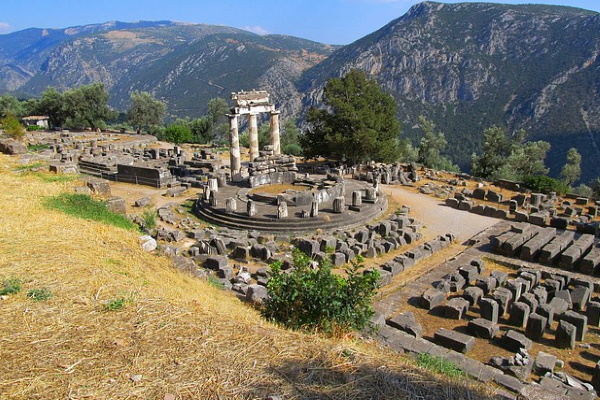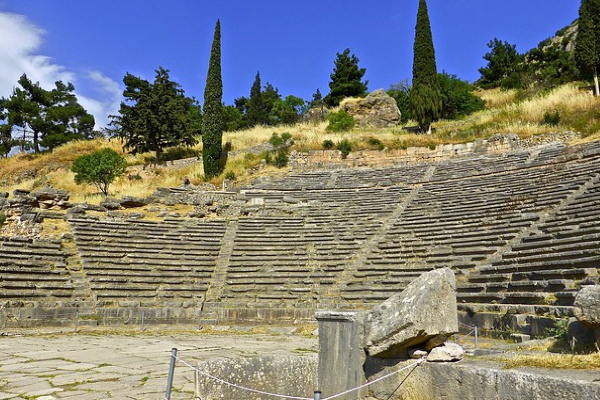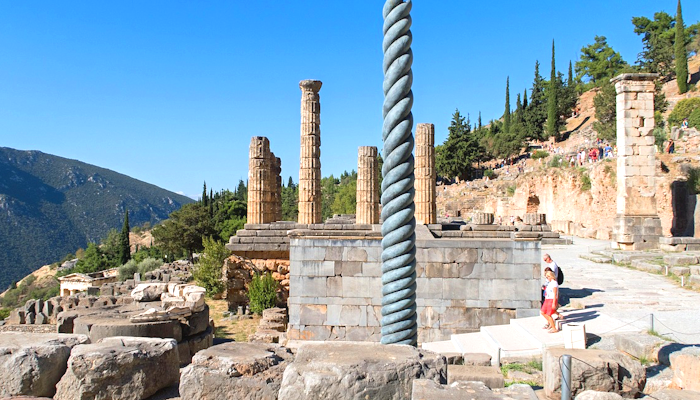Many visitors to Athens make one or more day trips to places of interest in the surrounding area. Many take a ferry to an island, others to ancient sites. A trip by bus to Delphi is particularly popular. Everybody knows the famous ancient oracle of Delphi, the prophecy site of ancient Greece.
>>>>> On this link: More info and booking

The famous oracle of Delphi, 2 to 3 hours by bus from Athens, is a great day trip. The tour buses stop at several other places along the way and for lunch. All in all you are on the road all day from Athens (about 10 hours).
>>>>> On this link: More info and booking of the trip to Delphi
If you are traveling by yourself, with a rental car or by public bus, you should buy your tickets in advance online at Getyourguide due to the large crowds and waiting times (also at the Delphi Museum)
There are several things to see in Delphi. The temple of Apollo is the most important building, here was the oracle of Delphi with the fortune teller. Also the big ancient amphitheater is very interesting.

Furthermore, the temple of Athena Pronaia is more than worth seeing. Also interesting is the great museum of Delphi. Here are some world-famous statues like the Sphinx of the Naxians made of bronze and the statue of Antinous.
The surroundings of Delphi are also a sight worth seeing. The excavation of the oracle is on the slope of a mountain of the Parnassus mountain range. The tour proposed by us also stops in some cities. Especially Arachova, a mountain town in the Parnassus mountains, is great.
Overall, a highly recommended day tour that can be booked with or without lunch. We recommend booking the meal; we enjoyed it. The bus tour is quite varied, and the online reviews from participants are consistently good. The bus tour runs daily in summer and several times a week in winter. If you visit the Delphi Oracle on this bus tour, a very good and knowledgeable guide through the oracle is also included. A guided tour of an ancient excavation site provides a wealth of additional information.
>>>> Click this link for more information and to book the tour
We believe the Oracle of Delphi was not only a day trip destination from Athens in ancient times, but is also worth a day trip today.
More information about Delphi
Delphi is an ancient Greek city located on the slopes of Mount Parnassus, overlooking the Gulf of Corinth. It was considered one of the most important religious sites in ancient Greece and was home to the famous Oracle of Delphi. In this section we look at the history and significance of Delphi, as well as the many tourist attractions the city has to offer today.

History of Delphi:
The history of Delphi begins long ago, when the city was still known as Python. According to legend, the god Apollo killed the serpent Python here and claimed the land as his own. The ancient Greeks considered Delphi the center of the world, and people came from all over the world to see the Delphic system, which was said to speak with the gods.
In the 6th century BC, the Temple of Apollo was built at Delphi and became one of the most important religious sites in Greece. The Oracle of Delphi became one of the most important religious sites in Greece. People sought advice on a variety of issues, from individual to collective. Kings, politicians, and military leaders sought advice at the temples before making important decisions.
Delphi played an important role in the wars between the Greeks and the Persians in the 5th century BC. The Athenians consulted the oracle before the Battle of Marathon, and the Spartans did the same before the Battle of Thermopylae. In the 4th century BC, Delphi was conquered by the Macedonians and sacked by the Romans in 279 BC.
In the following centuries, Delphi’s importance declined as the power of the Greek capital waned. The site was abandoned in the 4th century AD, and the Temple of Apollo was rebuilt in the 4th century.
Sights in Delphi:
Despite its long history, Delphi remains a popular tourist destination today. Visitors can explore the ruins of the ancient city, including the Temple of Apollo, theaters, and arenas. The site also houses a museum with artifacts from Delphi and the surrounding area.
The Temple of Apollo is the most impressive building in Delphi. Built in the 6th century BC, it was the center of religious activity in Delphi. The temple was destroyed by an earthquake and rebuilt several times before being destroyed by religious fanatics in the 4th century AD.
The Theater of Delphi is another impressive building. It was built in the 4th century BC and could seat up to 5,000 people. The theater was used for plays, among other things.
The Stadium of Delphi is also worth a visit. It was built in the 5th century BC and could seat up to 7,000 people. The arena was used for athletic competitions, including the Pythian Games, which were held every four years.
The Delphic Museum houses a collection of artifacts from the region and its surroundings. The museum’s collection includes sculptures, ceramics, and jewelry from ancient Greece.
Visiting Delphi:
Delphi is located 180 kilometers northwest of Athens and can be reached by car or bus. The site is open year-round, and visitors can purchase tickets at the gate. During peak tourist season, it can get very crowded, so it’s advisable to arrive early to avoid the crowds.
Delphi is a fascinating place for anyone interested in the history and culture of ancient Greece.
>>>>> On this link: More info and booking of the trip to Delphi
More information about the Delphi Oracle
The Delphi monument was a famous place in Greece where people sought advice and guidance from the gods. The sanctuary was located on the slopes of Mount Parnassus in central Greece and was dedicated to the god Apollo.
According to legend, the Oracle of Delphi was founded in the 8th century BC, when Apollo killed Python at this site. Python was sent by the goddess Hera to protect the sanctuary for her. After killing Python, Apollo claimed the site for himself and founded his temple there. The sanctuary of Delphi was famous for its prophecies, uttered by a priestess named Pythia. Pythia sat on a platform of clay above a fissure in the earth, drew smoke from a fire of bay leaves, and repeated her prophecy in the form of scales. The prophets were often secretive and open to interpretation, highly respected and sought after by people throughout the ancient world.
There were also many other important buildings and structures on the site of the Oracle of Delphi, including the Temple of Apollo, the Tholos, the Athenian Treasury, and the Temple of Apollo. The Temple of Apollo was the most important building on the site and contained a statue of the god Apollo. The Delphi Oracle remained an important religious site in ancient Greek history and was visited by many famous figures, including Alexander the Great, who consulted the scribe before embarking on his own conquest. The site was also the site of the Pythian Festivals, held every four years in honor of Apollo.
Today, the Oracle of Delphi is a popular tourist attraction and a UNESCO World Heritage Site. Visitors can explore the ruins of ancient buildings and learn about the history and legends of the area through guided tours and exhibitions.
TV documentary about the Oracle of Delphi (YouTube)
More information Temple of Apollo
The Temple of Apollo was an important building on the site of the Oracle of Delphi. It was dedicated to the god Apollo, considered the protector of the oracle and the god of prophecy, music, poetry, and archery.
The temple was built in the 4th century BC and replaced an ancient temple destroyed by fire. It was built on a terrace overlooking the Sanctuary of Apollo and was one of the most beautiful buildings of antiquity.
The temple is built in the Doric architectural style, characterized by strong, simple columns and a lack of decorative elements. It was constructed of local limestone and had six columns at the front and back, and fifteen columns on each side. The temple also had a central nave and two side aisles and was surrounded by a peristyle (columns surrounding the temple).
The interior of the temple was decorated with sculptures and paintings, and there was a large statue of Apollo made of gold and ivory. This statue was one of the most famous works of ancient Greece and was considered a masterpiece of sculpture.
The Temple of Apollo was not only a religious center, but also a cultural and political center. It hosted important festivals such as the Pythian Games and was attended by many famous figures, including philosophers, poets, and politicians.
Today, visitors to the oracle site of Delphi can explore the ruins of the Temple of Apollo and learn more about its history and significance. The temple is one of the most impressive and best-preserved structures on the site and offers a fascinating insight into the religious and cultural life of ancient Greece.
>>>> Follow this link: More information and booking of the excursion to Delphi
Those traveling independently, with a rental car or public bus, should purchase entrance tickets in advance online at Getyourguide due to the large crowds and waiting times (including at the Delphi Museum): Link to the booking page
More information about Delphi Stadium
The Delphi Stadium was an important venue for sporting events and part of the great Apollo complex. It was built in the 5th century BC and was used for various sports such as foot races, wrestling, and boxing.
The stadium was located at the foot of Mount Parnassus and could accommodate approximately 7,000 spectators. It was built in the Classical Greek style, with a long square building and a long railing. The track was 177 meters long and 25 meters wide and was surrounded on all sides by mud bricks to accommodate spectators. The arena was used for many important events, including the Pythian Games, held every four years in honor of Apollo. The Pythian Games were one of the four major games of ancient Greece, along with the Olympic Games, the Isthmus Games, and the Nemean Games. These events included running, wrestling, boxing, and the pentathlon (a competition involving five sports, including running, jumping, and throwing).
The stadium is also used for other events such as musical competitions and religious ceremonies. It was an important meeting place for people from all over Greece and a symbol of the unity and cultural pride of the Greek people. Today, visitors to the Oracle of Delphi can view the ruins of the arena and imagine the excitement and power of the ancient games. The stadium is one of the best-preserved buildings on the site and offers a glimpse into the sporting and cultural life of ancient Greece.
More info about the Delphi Theater
The Delphi Theater was one of the most important cultural and artistic centers in the world. It was built in the 4th century BC and was used for various miracles and musical performances, as well as for political and religious events.
The theater was located on the slopes of Mount Parnassus and offered beautiful views of the surrounding landscape. It had a capacity of approximately 5,000 spectators and was designed in the classical Greek style with an orchestra in the round (a circular area in the center of the theater where the actors stood), a raised platform, and tiered seating.
The theater hosted a variety of works, including tragedies, comedies, and musicals. These plays were performed in ancient Greek and were often written by famous writers such as Aeschylus, Sophocles, and Euripides. The theater was also used for important political and religious events, including meetings of the Amphictyonic Council, the political and religious body of ancient Greece.
The theater was an important cultural and artistic center for the ancient Greeks and was considered a symbol of their cultural success. It was also an important meeting place for people from all over Greece and played a vital role in the spread of Greek culture and ideas.
Today, visitors to the oracle site of Delphi can see the ruins of the theater and imagine the games and events that took place there. The theater is one of the best-preserved buildings on the site and offers an overview of the artistic and cultural life of ancient Greece.
Delphi Questions and Answers
Where is Delphi?
Delphi is located in Greece, about 120 kilometers northwest of Athens, in the region of Central Greece. It is situated on the southwest slope of Mount Parnassus, overlooking the valley of the Pleistos River.
The ancient city was one of the most important religious centers of ancient Greece and is best known for the Oracle of Delphi in the Temple of Apollo. Today, the archaeological site of Delphi is a UNESCO World Heritage Site and one of the most visited attractions in Greece.
What is the Oracle of Delphi?
The Oracle of Delphi was one of the most famous divination centers of antiquity. It was located in the Temple of Apollo at Delphi and was considered a sacred place where the gods conveyed their messages to humanity.
How did the oracle work?
The prophecies were delivered by the Pythia, a priestess of Apollo.
She sat on a tripod above a crevice in the rock, from which intoxicating vapors rose.
In a trance, she supposedly spoke incomprehensible words, which were interpreted by priests and passed on to the questioners.
The answers were often ambiguous, so they could be interpreted differently depending on the situation.
Importance of the Oracle
Kings, politicians, and generals from throughout the Greek world sought advice on important matters such as wars or government.
Famous examples include the prophecies to King Croesus of Lydia and to Themistocles before the Battle of Salamis.
The oracle was a central religious and political center of power for many centuries.
With the rise of Christianity and the decline of pagan beliefs, the oracle lost importance in the 4th century AD and was eventually closed. Today, the ruins of Delphi are one of the most important archaeological sites in Greece.
Who is the Oracle of Delphi under?
The Oracle of Delphi was officially under the authority of the god Apollo, as the temple where the prophecies were made was dedicated to Apollo. According to mythological tradition, Apollo himself is said to have founded the oracle after slaying the dragon Python, which had previously guarded the site.
In practice, the oracle was administered by several institutions:
1.The Pythia
She was the high-priestly seer who spoke the prophecies in a trance.
She was chosen from prominent Delphic families.
She was the central figure of the oracle but was under the supervision of the priesthood.
2.The Priests of Apollo
They interpreted the Pythia’s often incomprehensible utterances and formulated them in understandable language for those seeking advice.
They organized the proceedings and ensured that only wealthy visitors received preferential treatment.
3.The Amphictyonic Alliance
A coalition of Greek city-states that controlled the sanctuary.
It managed the revenues and secured Delphi’s independence.
There were several disputes over supremacy over the oracle (so-called Sacred Wars).
4.Powerful city-states such as Athens and Sparta
In various eras, influential Greek poleis had great influence over the oracle.
They used it for political purposes by influencing it in their favor.
In summary, the Oracle of Delphi was officially subordinate to Apollo, but was administered by the priesthood and was often a political instrument of powerful city-states and alliances.
What does Delphi mean?
Delphi is an ancient city in Greece, known for the Oracle of Delphi and the Temple of Apollo.
The name may come from the Greek word δελφύς (delphys), meaning “womb,” and may refer to an ancient fertility cult site.
Another theory connects the name with dolphins, as Apollo is said to have come to Delphi in the form of a dolphin.
What was the name of the Oracle of Delphi?
The Oracle of Delphi was represented by a priestess named Pythia. The name Pythia comes from the mythological serpent Python, which Apollo is said to have killed before taking over the oracle.
The Pythia was the high priestess of the Temple of Apollo and conveyed the god’s prophecies. Her actual personal name has rarely been recorded, as the title “Pythia” was adopted for each new priestess.
How to get to Delphi?
Delphi is located about 120 km northwest of Athens and is easily accessible. There are several ways to get there:
1. By car
Travel time: approximately 2.5 hours from Athens
Route:
From Athens, take the E75 national road towards Lamia.
From Thiva (Thebes) or Kastro, head towards Levadia and Arachova.
From Arachova (a picturesque mountain village), it’s only 10 km to Delphi.
Advantages: Flexibility, beautiful scenery, possibility of stopovers in Arachova or Hosios Luke Monastery.
2. By bus (cheap alternative)
Departure: From Kifissos bus station in Athens (KTEL buses).
Travel time: approx. 3 hours
Cost: approx. €20 each way
Tickets & times: Check in advance on the KTEL Fokida website or at the bus station.
Advantages: Cheap, direct connection without transfers.
3. With an organized tour ️
Many tour operators in Athens offer day trips to Delphi.
Often includes entrance tickets, guided tours, and transfers.
Price: approx. €50–100 depending on the provider.
Advantages: Convenient, no organization required, often with a guide.
Bookable through the popular ticket website Getyourguide.